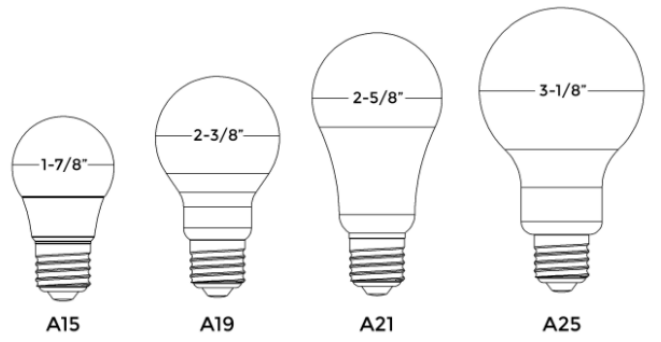How much money do you spend to keep the lights on?
To calculate how much money you spend every year to keep the lights on, we need to know 3 things:
- Wattage of each light bulb.
- Amount of hours that light bulb is on each year.
- Rate you pay for electricity.
Wattage
The wattage of a light bulb indicates how much power the bulb requires when it’s turned on. The wattage is usually written somewhere on the bulb. For example, if you see “60 W,” you know that the light bulb requires 60 Watts of power to operate. According to a study done by the US Department of Energy (DOE), the average wattage per bulb in US households is 38 W. Furthermore, the average US household has 52 light bulbs.
Hours
The amount of money you pay to power your lights depends on how often you have your lights turned on. Operating hours will vary per lighting fixture within your house, depending on which rooms you spend most time in when lighting is needed. The same study from the DOE mentioned above states that the average lightbulb is kept on for 2 hours per day, or 730 hours per year.
Price
Once you know the wattage for each light bulb and the approximate amount of hours you have it on every day, you can calculate how many kiloWatt-hours (kWh) you use for that light bulb every year. A kWh is a unit of energy, and this is the unit that electricity companies use to charge you for electricity consumption. The average electricity price in the US is $0.12 per kWh.
Total Cost for Lighting
For a typical household with 52 light bulbs, each an average of 38 W running at 730 hours per year, we can calculate the kWh used in one year. Keep in mind that there are 1,000 W in 1 kW, which is used in the equation below to determine the kWh used per year.

Multiplying the kWh per year by the cost per kWh, we can determine the average annual total cost for lighting per household:

Remember, this cost will change depending on how often you have your lights on, the wattage of your light bulbs, and the electricity price in your area. To more accurately calculate the cost for your lighting, it is helpful to use the equation above to calculate the price for each individual light bulb type and room. Then you can sum the price for each light bulb within your house. The excerpt from an Excel sheet shown below shows you how you can set up this calculation.

How can you reduce the amount of money you spend on lighting?
Turn the Lights Off
If you frequently forget to turn the lights off when you leave a room, purchasing occupancy sensors is the way to go. The sensors will turn the lights off if no movement is detected within the room after a certain amount of time. Motion sensors and timers are particularly useful for those that prefer to keep outdoor lights on at night.
Natural Lighting
Using natural lighting from windows and skylights is a simple strategy for reducing the need to pay for light bulb use! A couple of things to watch out for though: (1) Make sure the lighting is sufficient for the task at hand so you aren’t straining your eyes. (2) Make sure the sun shining through the windows isn’t adding too much heat to your house when you’re running the AC.
This latter point refers to the fact that windows tend to allow for heat to transfer in/out of your home. So if it’s super hot outside and you have the AC on, it’s best to keep the window blinds closed to reduce the heat flow from the outside. Blinds also block direct sun radiation from further heating your home. The more heat you let inside your house, the more expensive it is to run your AC. If the window feels hot when you touch it (compared to the temperature of an interior wall), you know that a lot of heat is being transferred from outside to inside. So keep the blinds shut to reduce the heat transfer!
Upgrade!
The 3 most common types of residential light bulb types are LED (light-emitting diode), CFL (compact fluorescent), and incandescent. Photos of standard versions of these technologies are shown below, with an LED on the left, an incandescent in the center, and a CFL on the right. Although, the latest LEDs can look exactly like the classic incandescent, without the casing on the bottom half.

Source: TFC Electric
LEDs are the latest and most efficient technology, so they cost less to operate than their CFL and incandescent counterparts. For example, a typical replacement for a standard 60-W incandescent bulb would be a 13-W CFL (78% cost savings) or an 8-W LED (87% cost savings).
And even better, LEDs last up to 25 times and 3 times longer than incandescent and CFL bulbs, respectively. So even though the capital cost of LEDs is more expensive than for CFLs and incandescent bulbs, LEDs are cheaper overall in the long run.

A 2017 study from the EIA showed that 71% of homes had 0 LEDs present within their lighting types, and only 1% of homes had fully converted to all LEDs. While these numbers have most likely improved over the last few years, this study shows that US households have ample room for savings when it comes to lighting!

What to look for when you upgrade your lighting
Utility Rebates
Several electricity utility companies across the US will provide you with free or discounted LED light bulbs if you are looking to make your household lighting more efficient! Call your electricity utility company to see their current offers and to see if they will take care of installation for you.
Free LEDs from the utility company might limit you in choosing the exact color, brightness, and shape of your light bulbs. If you choose to purchase lighting on your own, always make sure to choose the lowest wattage LED that meets your desired features! Let’s explore light bulb color, brightness, and shape a bit more so you aren’t overwhelmed with all the choices you’ll have when it comes to purchasing light bulbs!
Color Temperature
The color of typical light bulbs falls on a color spectrum from yellow-red (warm colors) to blue-green (cool colors). This is referred to as the color temperature of the light, which is measured in Kelvin (K). Higher temperatures (3600-5500K) represent cooler colors, and lower temperatures (2700-3000K) represent warmer colors. People generally prefer cool light for visual tasks and warm light for living spaces.
For example, GE has 3 light bulbs series called Relax, Refresh, and Reveal, each with a different color temperature. The table below shows the color temperature and typical household rooms for each of the bulb types. We upgraded the lighting in our house using the room suggestions in the table below, and the improvement in ambiance was staggering!

Luminosity
Luminosity, which measures how bright a light is, is the next item you want to consider. It is important to remember that higher wattage does not mean higher luminosity! If you want to ensure that your new LED is similar in brightness to your old light bulb, find the label on the LED packaging that says which type of incandescent it replaces. For example, you might see an 8-W LED that says “60-W replacement”; this just means that the 8-W LED will provide the same brightness as your old 60-W incandescent!
Light Bulb Shape
You’ll also notice a light bulb code on the packaging of new light bulbs, something like “A19” or “C9”. The letter indicates the shape of the bulb, and the number represents the diameter of the bulb in millimeters or eighths of an inch. This article does a great job of explaining how the light bulb codes correlate to bulb shape, bulb size, and base screw size! For example, “A” light bulbs are commonly found in households. The photo below shows the different diameter sizes for a few A bulbs. (A15 bulb: 15/8 = 1-7/8″ diameter; A19 bulb: 19/8 = 2-3/8″ diameter; A21 bulb: 21/8 = 2-5/8″ diameter; A25 bulb: 25/8 = 3-1/8″ diameter.)

Disposing of Old Light Bulbs
CFLs and other fluorescent bulbs contain toxic mercury, so these light bulbs must be appropriately recycled to avoid environmental contamination. You can usually drop these off at your local Lowe’s or Home Depot.
Disclaimer: Please consult with a professional before making any upgrades to lighting, electrical work, or electricity-consuming devices within your home. It All Adds Up and its affiliates are not responsible for any household damage or personal injuries that should occur from following any suggestions from It All Adds Up.
HAVE QUESTIONS?
Do you have a certain topic that you would like us to talk about?
READY TO SAVE?
Check out our latest episodes for tips and tricks to save you money!
ABOUT US
Get to know more about us and the team behind our podcast!
SUBSCRIBE
We send out a weekly email to our listeners that reviews that week’s episode! To join our mailing list, enter your email in the box below and hit “Subscribe.” Make sure to add [email protected] to your contact list.
